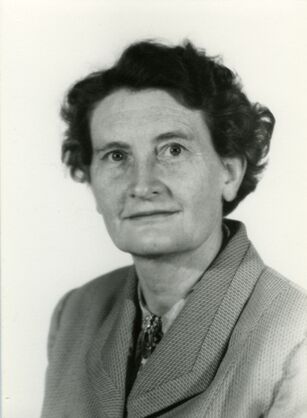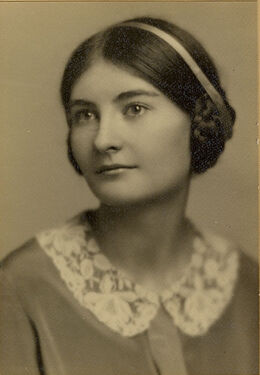
Dorothy Livesay (1909-1996). Courtesy McMaster University.
Dorothy Kathleen May Livesay, OC, OBC, FRSC (October 12, 1909 - December 29, 1996) was a Canadian poet who twice won the Governor General`s Award in the 1940s, and was "senior woman writer in Canada" during the 1970s and 1980s. [1]
Life[]

Livesay in 1926. Courtesy City of Mississauga.
Youth and education[]
Livesay was born in Winnipeg, Manitoba. Her mother, Florence Randal Livesay, was a poet and journalist, and her father, J.F.B. Livesay, was the General Manager of Canadian Press. [1]
Livesay moved to Toronto, Ontario, with her family in 1920.
She graduated with a B.A. in 1931 from Trinity College in the University of Toronto and received a diploma from the University of Toronto's Faculty of Social Work in 1934.
She also studied at the University of British Columbia and the Sorbonne.
Career[]
In 1931 in Paris, Livesay became a committed Communist. She joined the Communist Party of Canada in 1933, and was active in a number of its front organizations: the Canadian Labour Defense League, the Canadian League Against War and Fascism, Friends of the Soviet Union, and the Workers' Unity League.[2]
In 1937 she married Duncan Macnair, they had two children; Marcia, and anthropologist Peter Macnair.
In the early 1940s Livesay suggested to Anne Marriott, Floris McLaren, and Doris Ferne that they start a poetry magazine which would serve as a vehicle for poets outside the somewhat closed Montreal circle. Alan Crawley agreed to edit the magazine, and the premiere issue of Contemporary Verse appeared in September 1941,[3]
After Macnair died in 1959, Livesay worked for UNESCO in Paris, and then in Northern Rhodesia (now Zambia) as a field worker from 1960 to 1963.
Between 1951 and 1984, she was an instructor and a writer in residence at many Canadian universities, including the University of British Columbia (1951-1953 and 1966-1968), University of New Brunswick (1966-1968), University of Alberta (1968-1971), University of Victoria (1972-1974), University of Manitoba (1974-1976), Simon Fraser University (1980-1982), and University of Toronto (1983-1984).[4]
In 1975 Livesay founded the journal Contemporary Verse 2 (CVII).
She died in Victoria, British Columbia.
Writing[]
Livesay's debut collection of poetry, Green Pitcher, was published in 1928, when she was only 19. The Encyclopedia of Literature says, "these were well-crafted poems that not only showed skilled use of the imagist technique but prefigured Margaret Atwood's condemnations of exploitative and fearful attitudes to the Canadian landscape." The book "later disappointed Livesay by its failure to deal openly with social issues."[5]
She published her earliest short story, "Heat," in the Canadian Mercury at the same age (in January, 1929).[2]
Her 2nd book of poems, Signpost (1932), "showed the increasing sophistication of her imagist skills, as in 'Green Rain,' and an original sense of feminine sexuality."[5]
When her Selected Poems were published in 1956, Canadian literary critic Northrop Frye said of them:
- Miss Livesay is an imagist who started off, in Green Pitcher (1929), in the Amy Lowell idiom.... With Day and Night (1944) a social passion begins to fuse the diction, tighten the rhythm, and concentrate the imagery.... From Prelude for Spring on, the original imagist texture gradually returns.... The basis of Miss Livesay's imagery is the association between winter and the human death-impulse and between spring and the human capacity for life. Cutting across this is the irony of the fact that spring tends to obliterate the memory of winter, whereas human beings enjoying love and peace retain an uneasy sense of the horrors of hatred and war....
- The dangers of imagism are facility and slackness, and one reads through this book with mixed feelings. But it is one of the few rewards of writing poetry that the poet takes his ranking from his best work. Miss Livesay's most distinctive quality, I think, is her power of observing how other people observe, especially children. Too often her own observation goes out of focus, making the love poems elusive and the descriptive ones prolix, but in the gentle humour of "The Traveller," in "The Child Looks Out," in "On Seeing," in the nursery-rhyme rhythm of "Abracadabra," and in many other places, we can see what Professor Desmond Pacey means by "a voice we delight to hear." [6]
Livesay "was a tireless contributor to periodical publications her whole life, but beginning in the 1960s she contributed to the burgeoning critical discussion of Canadian literature through her writing as well as her affiliations with numerous academic institutions and magazines. She offered a theory that Canadian literature favoured a mode she called 'documentary poetry,' long narrative poems that comment on particular social topics and that 'are a conscious attempt to create a dialectic between the objective facts and the subjective feelings of the poet' ("The Documentary Poem: A Canadian Genre,"). Call My People Home (1950) - about the mistreatment of Japanese Canadians during World War II - and The Documentaries (1968) are examples of her own work in this genre." [4]
"Livesay is best known as a strong, sensitive poet dealing as capably with public and political issues as with personal and intimate emotion and reflection. She was senior woman writer in Canada during active and productive years in the 1970s and 1980s." [1]
Recognition[]
Livesay won the Governor General's Award, Canada's top poetry honor, twice: in 1944 for Day and Night, and in 1947 for Poems for People. [1]
The Royal Society of Canada elected her as a fellow, and awarded her its Lorne Pierce Medal, in 1947.
Livesay also won the Queen's Canada Medal in 1977, and the Persons Case Award for the Status of Women in 1984. [7]
In 1983 she was awarded an honorary doctorate from Athabasca University.[4]
In 1987 she became an Officer of the Order of Canada.[1]
In 1992 she was awarded the Order of British Columbia.
The Dorothy Livesay Poetry Prize is a category of the BC Book Prizes that is awarded to authors of the best work of poetry in a given year, where those authors are British Columbia or Yukon residents, or have been for three of the last five years. Originally known as the B.C. Prize for Poetry, in 1989 it was named after Livesay.
Publications[]
Poetry[]
- Green Pitcher. Toronto: Macmillan, 1928.
- Signpost. Toronto: Macmillan, 1932.
- Day and Night. Toronto: Ryerson, 1944.
- Poems for People. Toronto: Ryerson, 1947.
- Call My People Home. Toronto: Ryerson (Poetry Chapbooks), 1950.
- New Poems (edited by Jay Macpherson). Toronto: Emblem Books, 1955.
- Selected Poems, 1926-1956. Toronto: Ryerson Press, 1957.
- The Colour of God's Face. Vancouver: Unitarian Service Committee, 1964.
- The Unquiet Bed (illustrated by Roy Kiyooka). Toronto: Ryerson Press, 1967.
- The Documentaries: Selected longer poems. Toronto: Ryerson Press, 1968.
- Plainsongs. Fredericton, NB: Fiddlehead Poetry Books, 1969.
- Post - Operative Instructions. Kingston, ON: Quarry Press, 1970.
- Plainsongs Extended. Fredericton, NB: Fiddlehead Poetry Books, 1971
- Disasters of the Sun. Burnaby, BC: Blackfish Press, 1971.
- Collected Poems: The two seasons. Toronto: McGraw-Hill Ryerson, 1972.
- Nine Poems of Farewell. Windsor, ON: Black Moss Press, 1973.
- Ice Age. Erin, ON: Porcépic, 1975.
- Seagulls. Prince George, BC: n.p., 1975.
- Winter Ascending. Prince George, BC: Caledonia (Caledonia Writing Series), 1977.
- The Woman I Am: Best loved poems from one of Canada’s best loved poets. Erin, ON.: Porcépic, 1977; Guernica Editions, 1991.
- The Phases of Love: Adolescence, 1925-1928. Toronto: League of Canadian Poets (Poetry Flyers), 1980.
- The Raw Edges: Voices from our time. Winnipeg: Turnstone Press, 1981.
- The Phases of Love. Toronto: Coach House, 1983.
- Feeling the Worlds: New poems. Fredericton, NB: Goose Lane, 1984.
- Beyond War: The poetry. 1985.[8]
- The Self-Completing Tree: Selected poems. Victoria: Porcepic, 1986.
- Awakenings. Victoria, BC: Published for the Hawthorne Soc. by Reference West, 1991.
- Poetry Is Like Bread. Vancouver, BC: Colophon, 1991.
- Archive for Our Times: Previously uncollected and unpublished poems of Dorothy Livesay (edited by Dean J. Irvine). Vancouver: Arsenal Pulp Press, 1998.
Novel[]
- The Husband: A novella. Charlottetown, PEI: Ragweed, 1990.
Non-fiction[]
- A Winnipeg Childhood. Winnipeg, MB: Peguis, 1973.
- also published as Beginnings: A Winnipeg childhood. Toronto: New Press, 1976.[9]
- Beginnings (expanded edition of A Winnipeg Childhood). Winnipeg, MB: Peguis, 1988.
- Right Hand, Left Hand: A true life of the thirties. Erin, ON: Porcepic, 1977.[9]
- Journey With My Selves: A memoir, 1909-1963. Vancouver, BC: Douglas & McIntyre, 1991.[9]
Except where otherwise noted, bibliographic information courtesy Athabasca University..[10]

Such Silence by Dorothy Livesay , Canadian Poet- Declaimer - Diana Dastan -shorts
Audio / video[]

Dorothy livesay - bartok and the geranium
- Celebration: Famous Canadian Poets CD (with Eli Mandel). Canadian Poetry Association (CD#2), 2001. ISBN 1-55253-031-0
See also[]
References[]
Fonds[]
- Dorothy Livesay Fonds at University of Manitoba
- Dorothy Livesay fonds at University of Victoria, Special Collections
Notes[]
- ↑ 1.0 1.1 1.2 1.3 1.4 R.D. Mathews, "Livesay, Dorothy," Canadian Encyclopedia (Edmonton: Hurtig, 1988), 1233.
- ↑ 2.0 2.1 Peggy Kelly, "Politics, Gender, and New Provinces: Dorothy Livesay and F.R. Scott," Canadian Poetry: Studies/Documents/Reviews, No. 53, Fall/Winter, 2003.
- ↑ "(Joyce) Anne Marriott," Dictionary of Literary Biography, Bookrags.com, Web, Apr. 21, 2011.
- ↑ 4.0 4.1 4.2 "Dorothy Livesay," English-Canadian Writers, Athabasca University. Web, Mar. 19, 2011.
- ↑ 5.0 5.1 Frank Davey, "Dorothy Livesay Biography," Encyclopedia of Literature, JRank.org. Web, Mar. 23, 2011.
- ↑ Northrop Frye, "from 'Letters in Canada' - 1957," The Bush Garden (Toronto: Anansi, 1971), 84-86. Print.
- ↑ "Dorothy Livesay (1909-1996): Awards", Canadian Women Poets, Brock University. Web, Mar. 18, 2011.
- ↑ "Dorothy Livesay," Wikipedia, Wikimedia Foundation, Web, Mar. 11, 1991.
- ↑ 9.0 9.1 9.2 "[*Dorothy Livesay 1909-1996 , Canadian Women Poets, Brock University. Web, Mar. 18, 2011.
- ↑ Bibliography of Works by Dorothy Livesay, English-Canadian Writers, Faculty of Humanities & Social Sciences, Athabasca University, Web, July 2, 2012.
External links[]
- Poems
- Category:Dorothy Livesay at In a Dark Time ... the Eye Begins to See
- Audio / video
- Books
- Dorothy Livesay at Amazon.com
- Dorothy Livesay 1909-1996 at Canadian Women Poets
- About
- Dorothy Livesay in the Encyclopædia Britannica
- Dorothy Livesay in the Canadian Encyclopedia
- Dorothy Livesay at English-Canadian Writers
- Dorothy Livesay at the Dictionary of Unitarian and Universalist Biography
- "Dorothy Livesay and Call My People Home" at Historical Perspectives on Canadian Publishing
- "Dorothy Livesay: The love poetry" by Peter Stephens (.PDF)
- "'A Thankful Music': Dorothy Livesay's Experiments with Feeling and Poetic Form", Canadian Poetry
- Etc.
- Dorothy Livesay Poetry Prize, About BC Book Prizes
| This page uses Creative Commons Licensed content from Wikipedia. (view article). (view authors). |
| This page uses content from Wikinfo . The original article was at Wikinfo:Dorothy Livesay. The list of authors can be seen in the (view authors). page history. The text of this Wikinfo article is available under the GNU Free Documentation License and the Creative Commons Attribution-Share Alike 3.0 license. |
|